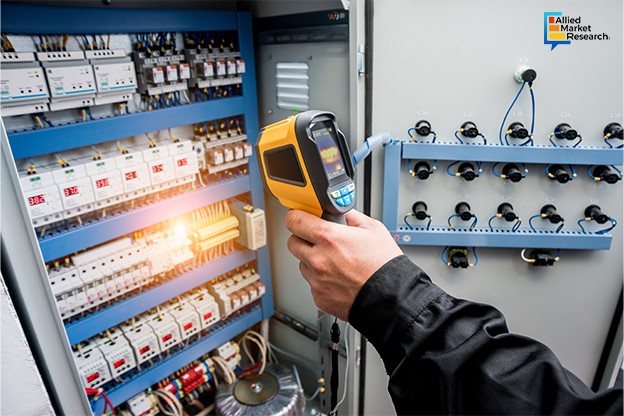Potential of Thermal Biosensors in Reshaping Various Leading Industries

13 May
2024
Highlights:
- Introduction
- Promising applicability of thermal biosensors
- Thermal biosensors in food processing units
Thermal biosensors are analytical devices that incorporate a biological sensing element intimately connected with a physical transducer. A biosensor employs a specific biological agent such as an enzyme, antibody or receptor to generate a specific chemical reaction. Thermal biosensors rely on the principle of detecting changes in temperature resulting from biochemical interactions. These sensors typically consist of a transducer that converts a biological signal into a measurable thermal response. Some common types of these analytical devices include thermistors, thermocouples, and microcalorimeters, offering improved speed, sensitivity, and specificity.
Potential use cases thermal biosensors across diverse fields
These sensors have gained huge popularity in the healthcare industry, offering a wide range of applications. In recent years, point-of-care testing (POCT) devices have emerged as an alternative for the detection and diagnosis of several diseases. These devices comprise of thermal biosensors that provide vitro diagnostics and other actionable healthcare information instantly. POCT also allows patients to self-test and self-managed care at their homes. It offers effective and rapid point-of-care diagnostics, revolutionizing public healthcare in both developed and developing countries.
Biosensing for point-of-care diagnostics is a research field that can be used in cheap, disposable point-of-care devices to provide continuous monitoring. Due to their beneficial advantages, the point-of-care diagnostics segment is expected to hold the largest share of the thermal biosensors industry, generating a revenue of $2,212.9 million from 2022 to 2032.
On the other hand, these biosensors are immensely gaining traction in home diagnostics. In the human body, multiple biological reactions happen that produce heat. These sensors are mainly used to measure serum cholesterol in individuals. When cholesterol is oxidized by the enzyme cholesterol, heat is produced that can be measured by thermal sensors. Additionally, they are also used to measure glucose, urea, uric acid, and penicillin G, enabling individuals to monitor their health at their convenience. Due to their high demands, the home diagnostics segment is expected to garner a significant revenue of $1484.7 million over the estimated period.
Furthermore, thermal biosensors are also integrated with wearable devices such as smartwatches, smart t-shirts, and tattoos to measure various biochemical reactions, including blood pressure, heart rate, blood glucose, and other parameters. Nowadays, these sensors are widely used by wearable device manufacturers to improve their ease of use to provide an authentic level of insight into patient’s real-time fitness status. Such data accessibility would result in making better clinical decisions, improved health outcomes, and more capable use of healthcare systems. For individuals, they help in the early detection of health issues and the prevention of hospital treatment. The sensors can reduce also help reduce hospital stays and readmissions.
Thermal biosensors in the food and beverage industry
In a food processing plant, food must be carefully monitored for its safety and quality during production. Food monitoring processes include various parameters such as process control, pH and conductivity, food freshness which include detection of microbes, detection of microbial toxins, ingredient freshness, and food quality including taste. The conventional methods for assessing the quality and safety of food were time consuming, require skill. This has increased the demand for quick, sensitive, and reliable techniques for quick monitoring of food quality and safety. Thermal biosensors help overcome these issues by offering quick, sensitive, and reliable techniques. These sensors can effectively help food processing units in various aspects such as food inspection, freezers, fermenting units, baking ovens, and smoking units. Due to their high level of functionality, different types of temperature sensors are used in this industry, which include thermistor, thermocouple, infrared sensor, and resistance temperature detector.
To conclude, the increase in the demand for thermal biosensors in the healthcare industry to indicate potential health concerns among individuals and improve patient outcomes is expected to boost the growth of the domain in the coming years. Moreover, the incorporation of thermal biosensors into wearable devices to revolutionize personal health monitoring is predicted to create immense growth opportunities for the sector in the future.
To gain more insights into the thermal biosensors industry, feel free to talk to our industry analysts today! They can also help you develop new business strategies and attract new investors.

Rosy Behera
Author's Bio- Rosy Behera holds a bachelor’s degree in Electrical and Electronics Engineering and now she is a content writer by profession. She loves to portray her thoughts and ideas with a nice command of words. Grabbing an audience with her creative write-ups is one of her biggest assets so far. Apart from writing, she is a certified “Odisi” dancer and has done Gardharva in Drawing, Painting, and Arts. She always explores new things through travel and is a big foodie.
Avenue: Entire Library membership of Allied Market Research Reports at your disposal
- Avenue is an innovative subscription-based online report database.
- Avail an online access to the entire library of syndicated reports on more than 2,000 niche industries and company profiles on more than 12,000 firms across 11 domains.
- A cost-effective model tailored for entrepreneurs, investors, and students & researchers at universities.
- Request customizations, suggest new reports, and avail analyst support as per your requirements.
- Get an access to the library of reports at any time from any device and anywhere.
Related Post
-
How are Submarine Cables Transforming Global Connectivity with Enhanced User Experience?
-
Endoscopy Procedures: Transformations in Techniques and Applications
-
AI-Powered Video Analytics: How the Product Actually Works for enterprises
-
Painting Robots: Transforming Precision Coating and Creative Applications
-
Innovations in Pharmacovigilance Systems Advancing Patient Safety
-
Understanding Edge Security: Keeping Data Safe Near the Source
-
Exploring the Use and Advancements of 3D Laser Scanners in Professional Applications
-
Reinforcing Industrial Controls with Smarter Tools and Training








